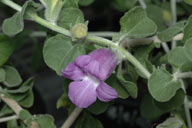In Flower This Week
A weekly news sheet prepared by a Gardens' volunteer.
Numbers before each plant refer to temporary IFTW labels in the gardens.
Numbers in square brackets [ ] refer to garden bed Sections. Plants in flower are in bold type.
View past issues of 'In Flower This Week'.
26 April 2013
Eremophila strongylophylla click for larger image |
Light fogs and frosts followed by lovely sunny days are ideal to view our autumn display, especially banksias which are now bursting into flower.
- Lechenaultia formosa, seen outside the Visitor Centre doors, continues to drape its startling orange-red flowers over the top of the container pot.
- On Banks Walk, in another pot Banksia heliantha [Section 174] displays its rounded yellow flower heads. Its immature heads are surrounded by fascinating dark bracts.
- Woollsia pungens [Section 174] is a wiry upright plant with small white flowers surrounding its terminal branches.
- Opposite is a mint bush, Prostanthera phylicifolia [Section 210], a dense shrub clad with soft mauve flowers.
- Following the road edging the Rainforest, standing proud is Grevillea bipinnatifida ‘Jingle Bells’ [Section 124] an upright plant crowned with spent flower heads, fresh red flower heads and many pendulous buds.
- Rounding the corner, Banksia spinulosa [Section 126] is a dense shrub bright with many upright cylindrical gold flower spikes ribbed with red styles.
- Grevillea ‘Goldfever’ [Section 124] has apricot-coloured flowers on this low spreading shrub.
- Towards the next corner, Scaevola albida [Section 124] is a dense groundcover profuse with small fanshaped mauve flowers.
- In front (below the branches of the ancient Eucalyptus mannifera) is Thryptomene ‘Pink Lace’ [Section 10], a low spreading plant clad in profusion with tiny pink flowers.
- At the next corner on the road to the left is Eremophila strongylophylla [Section 302], a small plant with deep purple bugle-shaped flowers.
- Further on, Eremophila maculata subsp. maculata [Section 302] is an open taller shrub bearing bright yellow flowers.
- Almost opposite is a group of Correa ‘Canberra Bells’ [Section 119], open plants decorated with red tube flowers with yellow mouths. This plant was selected to commemorate Canberra’s Centenary.
- Edging the upper level of the Brittlegum lawn, Grevillea ‘Robyn Gordon’ [Section 109] is a dense spreading shrub clad with divided leaves and prolific with large terminal flower sprays.
- Return to the road division where Eremophila microtheca [Section 7] is a long bare shrub crowned with fine short foliage and mauve bugle-shaped flowers.
- The opposite corner has a group of mint bushes, Westringia longifolia [Section 5]. They are dense shrubs with a scattering of small white flowers.
- Along this road to the right is Westringia brevifolia var. raleighii [Section 6], fairly open shrubs bearing soft mauve flowers.
- Almost opposite, Correa alba [Section 7] edges the road. It is quite dense and well clad with white star-shaped flowers.
- Take the path to the right at the zebra crossing where Banksia ‘Giant Candles’ [Section 30] is a large shrub with quite long cylindrical gold flower spikes.
- Take the left narrow path past Banksia ericifolia [Section 30], a more open shrub with much shorter golden flower spikes.
- Callistemon subulatus [Section 30] is quite dense with short fine leaves and bright red bottlebrush-like flowers
- At the curve, Callistemon ‘White Anzac’ [Section 30] is also dense. Alas, most flowers are finished but some white bottlebrushes remain...
- Pass by a few other callistemons to reach the Main Path and turn to the right to return to the cafe.
Barbara Daly
![Director of National Parks [logo]](../../../../images/dnp_90px.gif)







